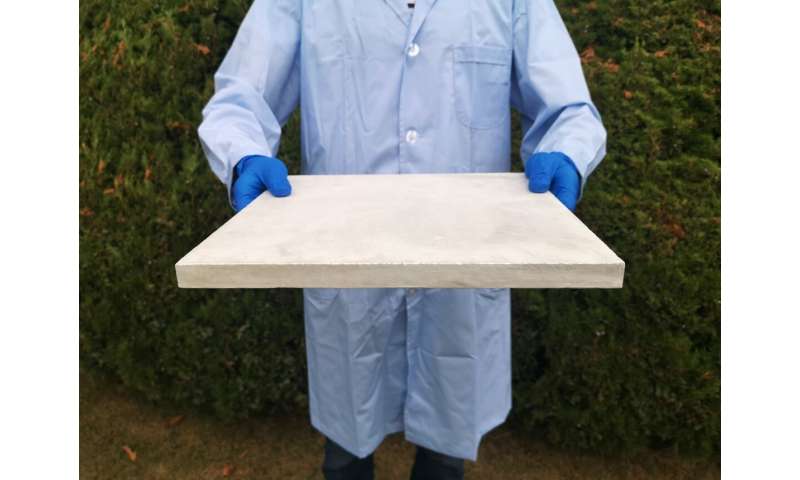Science
Tough, strong and heat-enduring: Bioinspired material to replace plastics – Phys.org

Modern life relies heavily on plastics, even though their petroleum-based production creates serious environmental challenges. Industry currently lacks sustainable alternatives due to their limited mechanical properties or complex manufacturing processes. An advanced strategy to design and produce high-performance sustainable structural materials is hence greatly needed.
Just such a new bioinspired material is now available to replace petroleum-based plastics. A team led by Prof. Shu-Hong Yu from the University of Science and Technology of China (USTC) reports a method to manufacture materials with similar structure as nacre from wood-derived fiber and mica, with adaption to mass production, good processability, and tunable coloration.
Natural nacre has a hierarchically ordered structure at multiscale levels, just like bricks and mortar, enabling it to be of both strength and toughness. Inspired by nacre, the researchers mimic the ordered brick-and-mortar structure using the TiO2 coated mica microplatelet (TiO2-mica) and cellulose nanofiber (CNF) by the proposed directional deforming assembly method.
This method directly presses the hydrogel of TiO2-mica and CNF, while keeps the size on in-plane directions unchanged. The thickness of the hydrogel is dramatically reduced and materials are directly constructed with the highly ordered brick-and-mortar structure.
At the nanoscale, the TiO2 nano-grains on the surface of TiO2-mica lead to efficient energy dissipation by frictional sliding during TiO2-mica pull-out. All the hierarchically ordered structure at multiscale levels contribute to the load redistribution and toughness enhancement.
-


A mobile phone case prototype made from this bioinspired material. Thanks to its good processability, the material can be fabricated into desired shape and size, showing a vast potential to replace plastics for practical applications, for example, structural support for high-end personal electronic device. Credit: GUAN Qingfang
-


Because the proposed manufacture method, directional deforming assembly, is effective and scalable, mass production of all-natural bioinspired structural material can be achieved. Credit: GUAN Qingfang
The obtained materials have excellent strength (~281 MPa) and toughness (~11.5 MPa m1/2), which are more than 2 times higher than those of high-performance engineering plastics (e.g., polyamides, aromatic polycarbonate), making it a strong competitor to petroleum-based plastics.
Even better, these materials adapt to temperature ranging from -130 °C to 250 °C, while normal plastics easily soften at high temperature. Therefore, such materials are safer and more reliable at high or variable temperatures.
Qing-Fang Guan et al, An all-natural bioinspired structural material for plastic replacement, Nature Communications (2020). DOI: 10.1038/s41467-020-19174-1
Provided by
University of Science and Technology of China
Citation:
Tough, strong and heat-enduring: Bioinspired material to replace plastics (2020, November 9)
retrieved 9 November 2020
from https://phys.org/news/2020-11-tough-strong-heat-enduring-bioinspired-material.html
This document is subject to copyright. Apart from any fair dealing for the purpose of private study or research, no
part may be reproduced without the written permission. The content is provided for information purposes only.
Science
SpaceX sends 23 Starlink satellites into low-Earth orbit


|
|
April 23 (UPI) — SpaceX launched 23 Starlink satellites into low-Earth orbit Tuesday evening from Space Launch Complex 40 at Cape Canaveral Space Force Station in Florida.
Liftoff occurred at 6:17 EDT with a SpaceX Falcon 9 rocket sending the payload of 23 Starlink satellites into orbit.
The Falcon 9 rocket’s first-stage booster landed on an autonomous drone ship in the Atlantic Ocean after separating from the rocket’s second stage and its payload.
The entire mission was scheduled to take about an hour and 5 minutes to complete from launch to satellite deployment.
The mission was the ninth flight for the first-stage booster that previously completed five Starlink satellite-deployment missions and three other missions.





Science
NASA Celebrates As 1977’s Voyager 1 Phones Home At Last


|
|
Voyager 1 has finally returned usable data to NASA from outside the solar system after five months offline.
Launched in 1977 and now in its 46th year, the probe has been suffering from communication issues since November 14. The same thing also happened in 2022. However, this week, NASA said that engineers were finally able to get usable data about the health and status of its onboard engineering systems.
Slow Work
Fixing Voyager 1 has been slow work. It’s currently over 15 billion miles (24 billion kilometers) from Earth, which means a radio message takes about 22.5 hours to reach it—and the same again to receive an answer.
The problem appears to have been its flight data subsystem, one of one of the spacecraft’s three onboard computers. Its job is to package the science and engineering data before it’s sent to Earth. Since the computer chip that stores its memory and some of its code is broken, engineers had to re-insert that code into a new location.
Next up for engineers at NASA’s Jet Propulsion Laboratory in California is to adjust other parts of the FDS software so Voyager 1 can return to sending science data.
Beyond The ‘Heliopause’
The longest-running and most distant spacecraft in history, Voyager 1, was launched on September 5, 1977, while its twin spacecraft, Voyager 2, was launched a little earlier on August 20, 1977. Voyager 2—now 12 billion miles away and traveling more slowly—continues to operate normally.
Both are now beyond what astronomers call the heliopause—a protective bubble of particles and magnetic fields created by the sun, which is thought to represent the sun’s farthest influence. Voyager 1 got to the heliopause in 2012 and Voyager 2 in 2018.
The Pale Blue Dot is a photograph of Earth taken Feb. 14, 1990, by NASA’s Voyager 1 at a distance of … [+]
NASA/JPL-Caltech
Pale Blue Dot
Since their launch from Cape Canaveral, Florida, aboard Titan-Centaur rockets, Voyager 1 and Voyager 2 have had glittering careers. Both photographed Jupiter and Saturn in 1979 and 1980 before going their separate ways. Voyager 1 could have visited Pluto, but that was sacrificed so scientists could get images of Saturn’s moon, Titan, a maneuver that made it impossible for it to reach any other body in the solar system. Meanwhile, Voyager 2 took slingshots around the planets to also image Uranus in 1986 and Neptune in 1989—the only spacecraft ever to image the two outer planets.
On February 14, 1990, when 3.7 billion miles from Earth, Voyager 1 turned its cameras back towards the sun and took an image that included our planet as “a mote of dust suspended in a sunbeam.” Known as the “Pale Blue Dot,” it’s one of the most famous photos ever taken. It was remastered in 2019.





Science
NASA hears from Voyager 1, the most distant spacecraft from Earth, after months of quiet
|
|
CAPE CANAVERAL, Fla. (AP) – NASA has finally heard back from Voyager 1 again in a way that makes sense.
The most distant spacecraft from Earth stopped sending back understandable data last November. Flight controllers traced the blank communication to a bad computer chip and rearranged the spacecraft’s coding to work around the trouble.
NASA’s Jet Propulsion Laboratory in Southern California declared success after receiving good engineering updates late last week. The team is still working to restore transmission of the science data.
It takes 22 1/2 hours to send a signal to Voyager 1, more than 15 billion miles (24 billion kilometers) away in interstellar space. The signal travel time is double that for a round trip.
Contact was never lost, rather it was like making a phone call where you can’t hear the person on the other end, a JPL spokeswoman said Tuesday.
Launched in 1977 to study Jupiter and Saturn, Voyager 1 has been exploring interstellar space – the space between star systems – since 2012. Its twin, Voyager 2, is 12.6 billion miles (20 billion kilometers) away and still working fine.





-



 Health15 hours ago
Health15 hours agoRemnants of bird flu virus found in pasteurized milk, FDA says
-
Art20 hours ago
Mayor's youth advisory council seeks submissions for art gala – SooToday
-



 Health19 hours ago
Health19 hours agoBird flu virus found in grocery milk as officials say supply still safe
-



 Investment19 hours ago
Investment19 hours agoTaxes should not wag the tail of the investment dog, but that’s what Trudeau wants
-
News19 hours ago
Peel police chief met Sri Lankan officer a court says ‘participated’ in torture – Global News
-



 Science23 hours ago
Science23 hours agoiN PHOTOS: Nature lovers celebrate flora, fauna for Earth Day in Kamloops, Okanagan | iNFOnews | Thompson-Okanagan's News Source – iNFOnews
-
Media14 hours ago
Vaughn Palmer: B.C. premier gives social media giants another chance
-
Art20 hours ago
An exhibition with a cause: Montreal's 'Art by the Water' celebrates 15 years – CityNews Montreal




